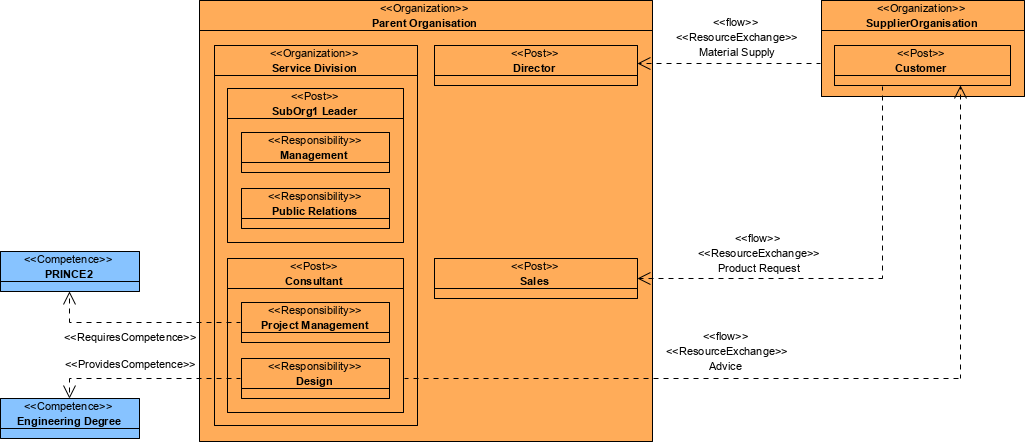The OV-4 shows organizational structures and interactions. The OV-4 exists in two forms; role-based (e.g., a typical brigade command structure) and actual (e.g., an organization chart for a department or agency).
A role-based OV-4 shows the possible relationships between organizational resources. The key relationship is composition, i.e., one organizational resource being part of a parent organization. In addition to this, the architect may show the roles each organizational resource has, and the interactions between those roles, i.e., the roles represent the functional aspects of organizational resources. Interactions illustrate the fundamental roles and management responsibilities, such as supervisory reporting, Command and Control (C2) relationships, collaboration and so on.
An actual OV-4 shows the structure of a real organization at a particular point in time, and is used to provide context to other parts of the architecture such as AV-1 and the CVs.
Usage
The intended usage of the role-based OV-4 includes:
- Organizational analysis.
- Definition of human roles.
- Operational analysis.
The intended usage of the actual OV-4 includes:
- Identify architecture stakeholders.
- Identify process owners.
- Illustrate current or future organization structures.
Product Description
The OV-4 addresses the organizational aspects of an Architectural Description.
A typical OV-4 illustrates the command structure or relationships (as opposed to relationships with respect to a business process flow) among human roles, organizations, or organization types that are the key players in the business represented by the architecture.
An actual OV-4 shows real organizations and the relationships between them.
DoDAF defines fundamental relationships between Organizational Resources; including structure (whole-part) and interaction. The interaction relationship covers most types of organizational relationship. Where there is a need for other types of organizational relationships, these should be recorded and defined in the AV-2 Integrated Dictionary as extensions to the DM2.
An OV-4 clarifies the various relationships that can exist between organizations and sub-organizations within the Architectural Description and between internal and external organizations.
Note that individual people are not viewed in DoDAF, but specific billets or Person Types may be detailed in an actual OV-4.
Creating an Organizational Relationships Chart
To create an Organizational Relationships Chart:
- Click on Organizational Relationships Chart in the Action Artifact area, and then select Create New Diagram.
- Type the diagram name and press Enter.
- A blank diagram is created and you can start constructing the view. Depending on whether you want to show a typical organization structure, an actual organization structure or a hybrid diagram that shows both of them, create the diagram with the elements below:Typical: Organization, Person, Post, ResponsibilityActual: ActualOrganization, ActualPerson, ActualPost, ActualResponsibility
Typical

Actual

DoDAF in Visual Paradigm
The DoDAF is brought to you by Visual Paradigm, a full-featured development platform. Visual Paradigm provides an easy-to-use, model-driven DoDAF tool that supports the development of DoDAF 2.02 views and models. You can create integrated DoDAF products and generate architectural documents that facilitate organizations to efficiently coordinate enterprise architecture initiatives.